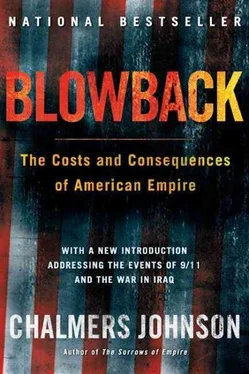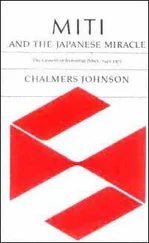Chalmers Johnson - Blowback, Second Edition - The Costs and Consequences of American Empire
Здесь есть возможность читать онлайн «Chalmers Johnson - Blowback, Second Edition - The Costs and Consequences of American Empire» весь текст электронной книги совершенно бесплатно (целиком полную версию без сокращений). В некоторых случаях можно слушать аудио, скачать через торрент в формате fb2 и присутствует краткое содержание. Год выпуска: 0101, ISBN: 0101, Издательство: Macmillan, Жанр: Старинная литература, на английском языке. Описание произведения, (предисловие) а так же отзывы посетителей доступны на портале библиотеки ЛибКат.
- Название:Blowback, Second Edition: The Costs and Consequences of American Empire
- Автор:
- Издательство:Macmillan
- Жанр:
- Год:0101
- ISBN:9780805075595
- Рейтинг книги:5 / 5. Голосов: 1
-
Избранное:Добавить в избранное
- Отзывы:
-
Ваша оценка:
- 100
- 1
- 2
- 3
- 4
- 5
Blowback, Second Edition: The Costs and Consequences of American Empire: краткое содержание, описание и аннотация
Предлагаем к чтению аннотацию, описание, краткое содержание или предисловие (зависит от того, что написал сам автор книги «Blowback, Second Edition: The Costs and Consequences of American Empire»). Если вы не нашли необходимую информацию о книге — напишите в комментариях, мы постараемся отыскать её.
Blowback, Second Edition: The Costs and Consequences of American Empire — читать онлайн бесплатно полную книгу (весь текст) целиком
Ниже представлен текст книги, разбитый по страницам. Система сохранения места последней прочитанной страницы, позволяет с удобством читать онлайн бесплатно книгу «Blowback, Second Edition: The Costs and Consequences of American Empire», без необходимости каждый раз заново искать на чём Вы остановились. Поставьте закладку, и сможете в любой момент перейти на страницу, на которой закончили чтение.
Интервал:
Закладка:
When it came to the political and military dimensions of satellite creation and maintenance, the Soviet Union and the United States pursued similar policies and for similar reasons. They controlled their dependencies through single-party dictatorships (in Japan’s case a one-party “democracy”) that either the Red Army or the U.S. Army installed in power and then supported throughout the Cold War against any and all popular efforts to introduce truly democratic regimes. Although rebellions against our military presence in Japan were endemic from 1952 until after the end of the Vietnam War, we helped maintain (often through CIA funds channeled to the ruling Liberal Democratic Party) a single-party regime from 1949 to 1993, a record for stable satellite government (although identical in length to that of the government of East Germany from 1945 to 1989). During this period Japan was led by the same types of “shameless mediocrities” that the French international relations theorist Raymond Aron once said the Soviet Union relied on to govern Eastern Europe. 1
Democracy finally began to appear in South Korea only in 1987, over four decades after the country came into being, largely because the military dictator, Chun Doo-hwan, had attracted the Olympic Games for the following year and so had trapped himself into behaving in a civilized manner before a global audience when Koreans began to protest his rule. Much as in 1989, when the Russians did not intervene militarily to stop the East Germans from tearing down the Berlin Wall, the United States in 1987 did not encourage its Korean military allies to use force, as it had done in the past. One reason was that American officials still had in mind the traumatic outcome of the Iranian revolution—when their down-the-line support of the Shah’s repressive rule had only accelerated the coming to power of Ayatollah Ruhollah Khomeini and an implacably anti-American regime. Just the previous year, in February 1986, they thought they saw similar events unfolding in the Philippines as a popular movement swept away another U.S.-supported but corrupt and incompetent dictator, Ferdinand Marcos. In that case, the United States did not support the repression of the rebels, and the results proved relatively satisfying when Corazon Aquino, the widow of an assassinated Marcos opponent, and a group of middle-class reformers came to power, backed by military men with strong ties to the United States. Thus, the American government again showed restraint in the Korean situation, and the student demonstrators with their middle-class backers, seizing the chance, brought into being what is today the only democracy in East Asia, other than the Philippines, that rests on popular political action from below.
The end of World War II had proved no more a “liberation day” for Korea than for Czechoslovakia or other nations of Eastern Europe. The Japanese had occupied, colonized, and exploited Korea since 1905, just as the Nazis, following the 1938 Munich Agreement, had divided, occupied, and ravished Czechoslovakia. Both countries now underwent transformations into colonies of the victors of World War II. At about the same time in February 1948 when the Communist Party of Czechoslovakia was carrying out a coup d’état in Prague, right-wing forces in the southern half of divided Korea, then under the control of the United States, were slaughtering at least thirty thousand dissident peasants on the island of Cheju. Although the Czech events are much better known (and led to the creation of NATO the following year), the killings in Korea were of essentially the same character as those in Czechoslovakia. The Cheju massacre was part of a process by which our puppet regime in South Korea, a government every bit as unpopular as Klement Gottwald’s Stalinist government in Czechoslovakia, consolidated power. Gottwald, president of Czechoslovakia from 1948 until his death in 1953, and Syngman Rhee, president of South Korea from 1948 to 1960, were, in fact, similar figures: neither could have come to power without the aid of his superpower patron and both were prototypes of the faceless bureaucrats the Soviets and the Americans would use for the next forty years to govern their “captive nations” (a term the Eisenhower administration came to apply to the Soviet Union’s satellites).
Between Japan’s surrender on August 15, 1945, and the installation of Syngman Rhee (who claimed to be a former Princeton student of Woodrow Wilson’s) as president of the Republic of Korea in the southern half of that peninsula on August 15, 1948, the Koreans themselves tried desperately to create a postcolonial government of their own, just as the Czechs struggled to create a democratic government under President Edvard Benes up to February 25, 1948. They were ultimately undone by superpower rivalries. Fearing that the United States was setting up Japan as its chief client in postwar Asia, the Soviets held on to Korea above the 38th parallel as a bulwark against Japanese influence. There, they promoted and endorsed a Communist government made up of former guerrilla fighters against the Japanese.
The Americans were more ambiguous about what they were doing. General John Hodge and his U.S. Army veterans of the Battle of Okinawa were the legal successors to the Japanese in South Korea. Only in 1948 did they hand over power to Rhee, and even then they retained operational authority over the South Korean armed forces and national police for another year. Preoccupied with the security of Japan and indifferent to Korea’s status, Hodge ended up thwarting the efforts of patriots such as Kim Ku to reconcile with the North Koreans. Instead, he moved to support Syngman Rhee, who himself was supported by and who staffed his new government with numerous former collaborators with the Japanese whose main credential was their firm and reliable anticommunism. The forces under Hodge’s command then trained and supervised Rhee’s armed forces in the suppression of any and all dissenters—invariably labeled “Communists”—and waited to see whether Rhee could consolidate his power.
Following the departure of the Japanese, the people of Cheju, a remote island off the extreme southern coast of Korea, governed themselves through patriotic “people’s committees” that were socialist but not Communist in orientation, as even General Hodge acknowledged. On April 3, 1948, Rhee’s police fired on a demonstration commemorating the Korean struggle against Japanese rule. This incident led to a general insurrection on the island against the police and their attempt to integrate Cheju into the new South Korean regime. Rhee responded with a campaign similar to that of the Indonesian Army in East Timor or of the Serbs in Bosnia and Kosovo. His police carried out a merciless assault on the people of Cheju, killing from thirty thousand to sixty thousand of them in the course of a few months and forcing another forty thousand to flee to Japan. On May 13, 1949, the American ambassador to the Republic of Korea, John Muccio, wired Washington that most rebels and sympathizers on Cheju had been “killed, captured, or converted.” 2
By far the most ruthless of Rhee’s agents was a paramilitary vigilante organization called the Northwest Youth League, composed of refugees from North Korea, whom the U.S. Army tolerated with full knowledge of their reputation for brutality. The American occupation authorities, in fact, directly funded and trained a similar organization, the Korean National Youth League, under its leader Yi Pom-sok (known to the Americans as “Bum Suk Lee”), as a right-wing paramilitary organization. The “youths” were aged eighteen to fifty. Northwest Youth League members, who were not funded by the U.S. Army, were, of course, rabidly anti-Communist but they also were interested in securing their own livelihoods by acquiring wealth and wives in South Korea. They were responsible for the widely documented sadistic treatment of Cheju’s women, including forcing female survivors of families they killed to marry them and cede their land to them. Some of these men still reside in Cheju today, having profited from the island’s contemporary status as a beach and golf resort. In April 1996, when President Kim Young-sam used the beachfront Cheju Shilla Hotel as the site of his summit meeting with President Clinton, no American journalist mentioned Cheju’s past, much less the similarity between Clinton’s mindless visit to Cheju and former President Reagan’s mindless visit to a cemetery for former SS soldiers in Bitburg, Germany, in 1985. 3At an August 1998 international conference on the fiftieth anniversary of the Cheju uprising held in Cheju City, many speakers noted that Clinton had played golf on the unmarked graves of Syngman Rhee’s victims.
Читать дальшеИнтервал:
Закладка:
Похожие книги на «Blowback, Second Edition: The Costs and Consequences of American Empire»
Представляем Вашему вниманию похожие книги на «Blowback, Second Edition: The Costs and Consequences of American Empire» списком для выбора. Мы отобрали схожую по названию и смыслу литературу в надежде предоставить читателям больше вариантов отыскать новые, интересные, ещё непрочитанные произведения.
Обсуждение, отзывы о книге «Blowback, Second Edition: The Costs and Consequences of American Empire» и просто собственные мнения читателей. Оставьте ваши комментарии, напишите, что Вы думаете о произведении, его смысле или главных героях. Укажите что конкретно понравилось, а что нет, и почему Вы так считаете.










